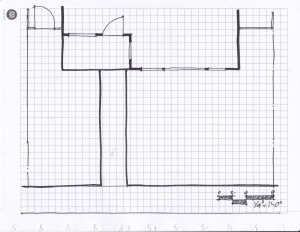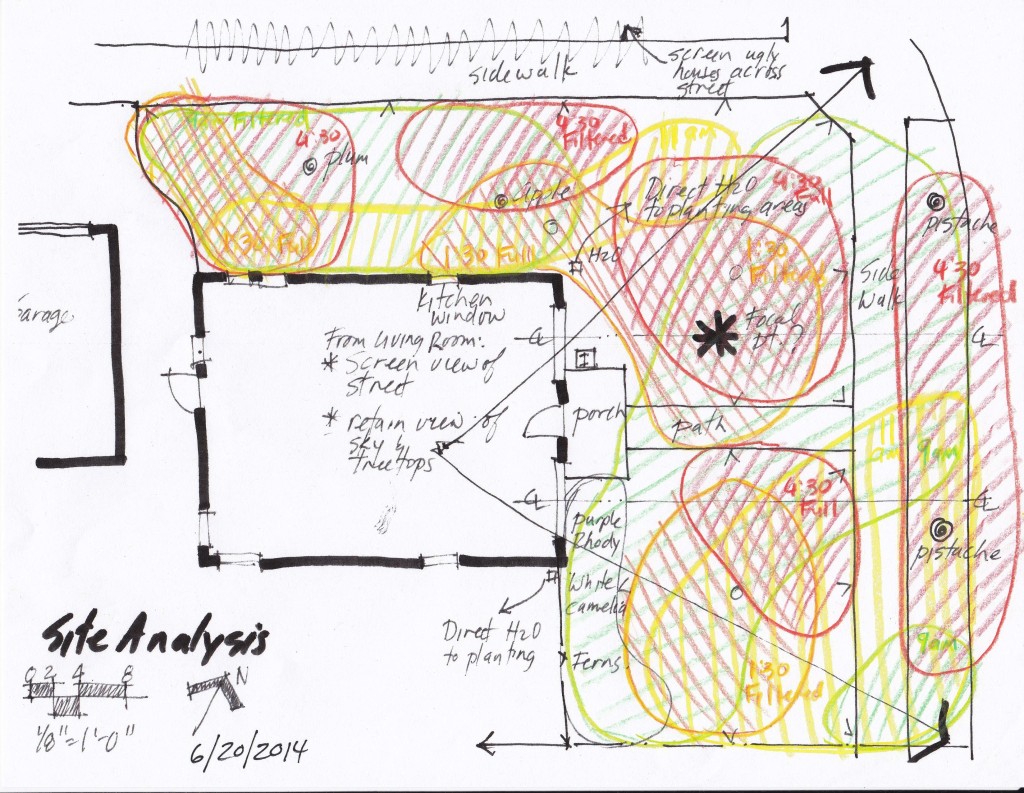Planting design is the art of arranging plants in a garden. There are many ways to approach it, but I find that exploring four basic questions leads to great planting design:
- What can I give my plants?
- What garden style do I want?
- What plant ‘jobs’ need to be filled in my yard?
- Is my yard ready to plant?
This article focuses on question one.
What can I give my plants? Matching plants to your aesthetic and functional needs and your site’s cultural conditions leads to a healthy and beautiful garden with reduced maintenance and water use. To gain a solid understanding of what you can offer plants, perform a simple site analysis.
Start by drawing a base map, to scale, of the site. Include the house footprint, the location of doors and windows, existing plants that you want to keep, hard scape areas such as paving and fencing, and utilities. Note the architectural style of your home. Make several copies of your base map.
Observe and record onto your base map information that you want to consider when designing your garden. First, note your yard’s relationship to your home. This could include locations of features that you want to screen or highlight when viewed from within your house, points of access, and rooms within your house that relate to activities that you plan to do outside of the house.
Next, note slope and drainage issues including areas that puddle easily or slopes that cause water run-off. Finally, consider the relationship to neighboring properties; record features such as large trees or buildings that cast shade on your yard, unattractive items that need to be screened or beautiful elements that you want to ‘borrow’ for your scenery.
Next, determine cultural conditions – solar exposure, soil texture, water, and maintenance – that will affect plant growth. Knowing your cultural conditions will lead you to select appropriate plant species.
Solar exposure is the amount and angle of the sunlight. Create a solar exposure map on a copy of your base map by recording shade patterns over the course of a single summer day. Every two hours, use a different colored pencil to sketch in the approximate shape and location of shadows. Use cool colors such as blue, green, and purple in the morning, warm colors such as red and orange in the afternoon. Note the time of each recording.
Soil texture refers to the proportions of different sizes of mineral (sand, silt, and clay) and organic particles in soil. Sandy soils have a large percentage of coarser particles. These soils drain fast, lose nutrients quickly, and are easily eroded. On the other end of the soil texture spectrum, clay soils have finer particles, hold water, retain nutrients, and are easily compacted. Most soils are composed of a mix of sand, soil, and clay soils with varying amounts of organic matter. Look up online how to use the soil texture “ribbon test” to quickly estimate your soil type.
For water analysis, know your average annual rainfall, and decide how much fake rain you are willing to provide through supplemental irrigation. Choose your irrigation methods (drip, spray, hand watering), and check if you need to replace or update any existing irrigation systems.
Maintenance means the weeding, deadheading, pruning, raking, etc. required to keep a garden looking good. All gardens require some level of maintenance but plant choice and design style greatly affect the level of maintenance. Who will be maintaining your garden? What is their level of experience? How much time will be spent maintaining your garden? Your planting design should reflect your maintenance abilities. Formal gardens with many plants that are poorly adapted will require skilled care and much more maintenance than naturalistic gardens with plants that have evolved to thrive under your cultural conditions.
Once you have created a base map and performed a site analysis you will know the growing conditions that you can offer your plants.
Thank you to Laura Lukes, Butte County Master Gardener, who co-wrote this article.

